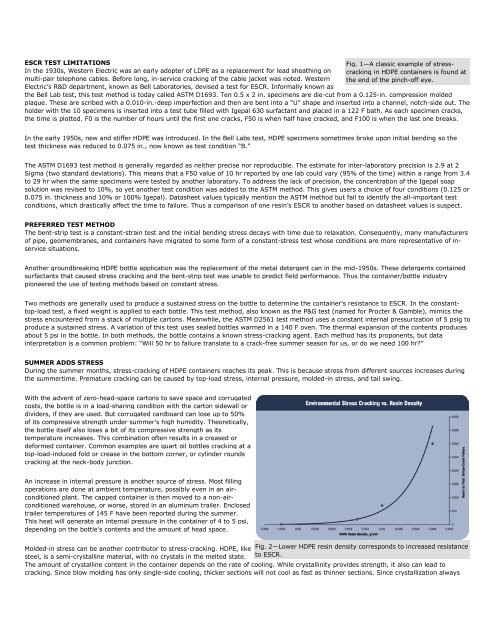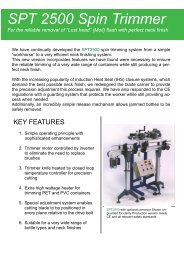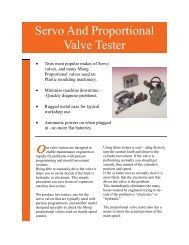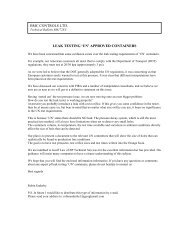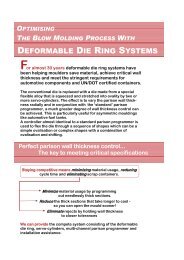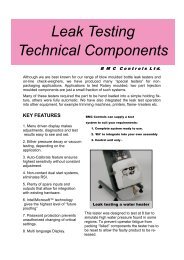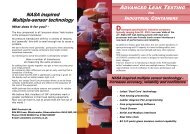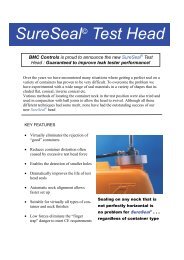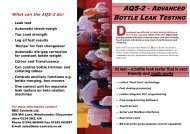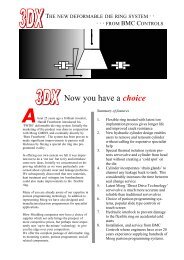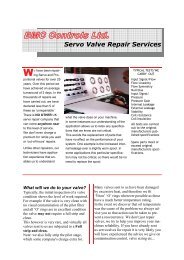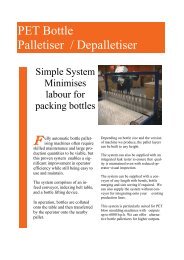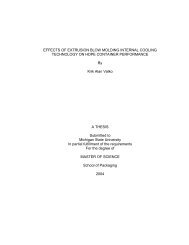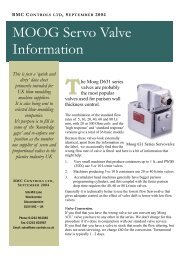Troubleshooting: Blow Molding Get a Handle on Stress-Cracking In ...
Troubleshooting: Blow Molding Get a Handle on Stress-Cracking In ...
Troubleshooting: Blow Molding Get a Handle on Stress-Cracking In ...
You also want an ePaper? Increase the reach of your titles
YUMPU automatically turns print PDFs into web optimized ePapers that Google loves.
ESCR TEST LIMITATIONS<br />
<strong>In</strong> the 1930s, Western Electric was an early adopter of LDPE as a replacement for lead sheathing <strong>on</strong><br />
multi-pair teleph<strong>on</strong>e cables. Before l<strong>on</strong>g, in-service cracking of the cable jacket was noted. Western<br />
Electric’s R&D department, known as Bell Laboratories, devised a test for ESCR. <strong>In</strong>formally known as<br />
Fig. 1—A classic example of stresscracking<br />
in HDPE c<strong>on</strong>tainers is found at<br />
the end of the pinch-off eye.<br />
the Bell Lab test, this test method is today called ASTM D1693. Ten 0.5 x 2 in. specimens are die-cut from a 0.125-in. compressi<strong>on</strong> molded<br />
plaque. These are scribed with a 0.010-in.-deep imperfecti<strong>on</strong> and then are bent into a “U” shape and inserted into a channel, notch-side out. The<br />
holder with the 10 specimens is inserted into a test tube filled with Igepal 630 surfactant and placed in a 122 F bath. As each specimen cracks,<br />
the time is plotted. F0 is the number of hours until the first <strong>on</strong>e cracks, F50 is when half have cracked, and F100 is when the last <strong>on</strong>e breaks.<br />
<strong>In</strong> the early 1950s, new and stiffer HDPE was introduced. <strong>In</strong> the Bell Labs test, HDPE specimens sometimes broke up<strong>on</strong> initial bending so the<br />
test thickness was reduced to 0.075 in., now known as test c<strong>on</strong>diti<strong>on</strong> “B.”<br />
The ASTM D1693 test method is generally regarded as neither precise nor reproducible. The estimate for inter-laboratory precisi<strong>on</strong> is 2.9 at 2<br />
Sigma (two standard deviati<strong>on</strong>s). This means that a F50 value of 10 hr reported by <strong>on</strong>e lab could vary (95% of the time) within a range from 3.4<br />
to 29 hr when the same specimens were tested by another laboratory. To address the lack of precisi<strong>on</strong>, the c<strong>on</strong>centrati<strong>on</strong> of the Igepal soap<br />
soluti<strong>on</strong> was revised to 10%, so yet another test c<strong>on</strong>diti<strong>on</strong> was added to the ASTM method. This gives users a choice of four c<strong>on</strong>diti<strong>on</strong>s (0.125 or<br />
0.075 in. thickness and 10% or 100% Igepal). Datasheet values typically menti<strong>on</strong> the ASTM method but fail to identify the all-important test<br />
c<strong>on</strong>diti<strong>on</strong>s, which drastically affect the time to failure. Thus a comparis<strong>on</strong> of <strong>on</strong>e resin’s ESCR to another based <strong>on</strong> datasheet values is suspect.<br />
PREFERRED TEST METHOD<br />
The bent-strip test is a c<strong>on</strong>stant-strain test and the initial bending stress decays with time due to relaxati<strong>on</strong>. C<strong>on</strong>sequently, many manufacturers<br />
of pipe, geomembranes, and c<strong>on</strong>tainers have migrated to some form of a c<strong>on</strong>stant-stress test whose c<strong>on</strong>diti<strong>on</strong>s are more representative of inservice<br />
situati<strong>on</strong>s.<br />
Another groundbreaking HDPE bottle applicati<strong>on</strong> was the replacement of the metal detergent can in the mid-1950s. These detergents c<strong>on</strong>tained<br />
surfactants that caused stress cracking and the bent-strip test was unable to predict field performance. Thus the c<strong>on</strong>tainer/bottle industry<br />
pi<strong>on</strong>eered the use of testing methods based <strong>on</strong> c<strong>on</strong>stant stress.<br />
Two methods are generally used to produce a sustained stress <strong>on</strong> the bottle to determine the c<strong>on</strong>tainer’s resistance to ESCR. <strong>In</strong> the c<strong>on</strong>stanttop-load<br />
test, a fixed weight is applied to each bottle. This test method, also known as the P&G test (named for Procter & Gamble), mimics the<br />
stress encountered from a stack of multiple cart<strong>on</strong>s. Meanwhile, the ASTM D2561 test method uses a c<strong>on</strong>stant internal pressurizati<strong>on</strong> of 5 psig to<br />
produce a sustained stress. A variati<strong>on</strong> of this test uses sealed bottles warmed in a 140 F oven. The thermal expansi<strong>on</strong> of the c<strong>on</strong>tents produces<br />
about 5 psi in the bottle. <strong>In</strong> both methods, the bottle c<strong>on</strong>tains a known stress-cracking agent. Each method has its prop<strong>on</strong>ents, but data<br />
interpretati<strong>on</strong> is a comm<strong>on</strong> problem: “Will 50 hr to failure translate to a crack-free summer seas<strong>on</strong> for us, or do we need 100 hr?”<br />
SUMMER ADDS STRESS<br />
During the summer m<strong>on</strong>ths, stress-cracking of HDPE c<strong>on</strong>tainers reaches its peak. This is because stress from different sources increases during<br />
the summertime. Premature cracking can be caused by top-load stress, internal pressure, molded-in stress, and tail swing.<br />
With the advent of zero-head-space cart<strong>on</strong>s to save space and corrugated<br />
costs, the bottle is in a load-sharing c<strong>on</strong>diti<strong>on</strong> with the cart<strong>on</strong> sidewall or<br />
dividers, if they are used. But corrugated cardboard can lose up to 50%<br />
of its compressive strength under summer’s high humidity. Theoretically,<br />
the bottle itself also loses a bit of its compressive strength as its<br />
temperature increases. This combinati<strong>on</strong> often results in a creased or<br />
deformed c<strong>on</strong>tainer. Comm<strong>on</strong> examples are quart oil bottles cracking at a<br />
top-load-induced fold or crease in the bottom corner, or cylinder rounds<br />
cracking at the neck-body juncti<strong>on</strong>.<br />
An increase in internal pressure is another source of stress. Most filling<br />
operati<strong>on</strong>s are d<strong>on</strong>e at ambient temperature, possibly even in an airc<strong>on</strong>diti<strong>on</strong>ed<br />
plant. The capped c<strong>on</strong>tainer is then moved to a n<strong>on</strong>-airc<strong>on</strong>diti<strong>on</strong>ed<br />
warehouse, or worse, stored in an aluminum trailer. Enclosed<br />
trailer temperatures of 145 F have been reported during the summer.<br />
This heat will generate an internal pressure in the c<strong>on</strong>tainer of 4 to 5 psi,<br />
depending <strong>on</strong> the bottle’s c<strong>on</strong>tents and the amount of head space.<br />
Molded-in stress can be another c<strong>on</strong>tributor to stress-cracking. HDPE, like<br />
steel, is a semi-crystalline material, with no crystals in the melted state.<br />
Fig. 2—Lower HDPE resin density corresp<strong>on</strong>ds to increased resistance<br />
to ESCR.<br />
The amount of crystalline c<strong>on</strong>tent in the c<strong>on</strong>tainer depends <strong>on</strong> the rate of cooling. While crystallinity provides strength, it also can lead to<br />
cracking. Since blow molding has <strong>on</strong>ly single-side cooling, thicker secti<strong>on</strong>s will not cool as fast as thinner secti<strong>on</strong>s. Since crystallizati<strong>on</strong> always


